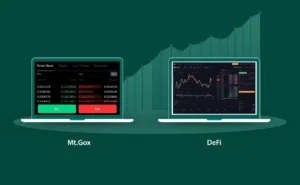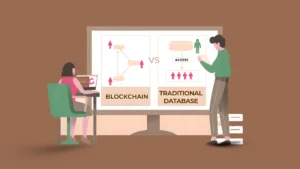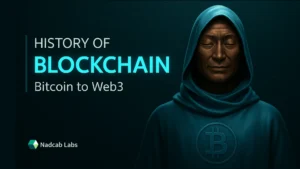
Multi chain bridges are essential tools that enable the transfer of assets and data between different blockchain networks. As blockchain technology continues to evolve, smooth network exchange between chains is becoming increasingly important. In this blog, we’ll explore what multi-chain bridges are, why they matter, and how to build them. We’ll also cover the various development services available to help you create your own multi-chain bridge and explain why partnering with a blockchain interoperability solution can make the process smoother and more secure.
What is a Multi-Chain Bridge?
A technology known as a multi-chain bridge enables users to move assets between various blockchain networks. For example , imagine it as a bridge that joins two islands, each of which stands for a distinct blockchain. Blockchains mainly function independently, making it hard for users to transfer coins or data across them. This issue is solved by multi-chain bridges that offer a secure way of transferring data and tokens across several networks. These bridges are essential because they enhance data transfer between blockchains, allowing users to take advantage of the unique features of different networks. For instance, to be able to access different trading opportunities or lower expenses, a user may want to transfer tokens from the Ethereum blockchain to the Binance Smart Chain. Multi-chain bridges makes this possible.
Blockchain Bridge Solutions
The process of building blockchain bridges, also known as multi-chain bridges, entails developing a reliable system that permits the transfer of data and digital assets between several blockchain networks. In order to comprehend the particular needs and features of the networks involved, extensive study is done at the start of the development process. The bridge’s architecture is designed by developers to ensure that it can safely link and communicate with various chains, enabling smooth transactions.
The next step is coding, where application logic and smart contracts are put into practice to effectively handle asset transfers. Because it establishes how assets are locked on one chain and released on another, this stage is crucial. Thorough testing is necessary to find and fix any possible problems, guaranteeing that the bridge operates properly and safely before deployment. After it is put into use, the bridge needs constant upkeep and updates to improve security and adjust to developments in blockchain technology.
Building multi-chain bridges requires programming expertise, a thorough understanding of blockchain protocols, and a strong emphasis on security to safeguard users’ funds during transactions. By working with a seasoned cross-chain bridge creation company, you may lower the possibility of mistakes and vulnerabilities by having professionals manage every step of the process.
Types of Multi-Chain Bridge Solutions
-
Atomic Swaps
Atomic swaps are an easy way for users on separate blockchains to immediately exchange different cryptocurrencies without the need for an exchange or other third party. Let’s say you wish to exchange your Bitcoin for another person’s Ethereum. Both exchanges take place simultaneously with atomic swaps. Neither user loses their assets if one side of the trade fails for any reason because the other side automatically cancels. Because there is no chance of one person stealing the assets, this approach makes trading safe and effective.
-
Wrapped Tokens
You can use one cryptocurrency on another blockchain through wrapped tokens. As an example, you can create a wrapped version of Bitcoin called Wrapped Bitcoin (WBTC) if you have Bitcoin but want to use it on the Ethereum network. This wrapped token is backed by real Bitcoin that remains in a secure place. Therefore, you are effectively utilising Bitcoin on the Ethereum network when you have WBTC. Wrapped tokens allow users to retain their original assets while engaging in a variety of decentralised finance (DeFi) services.
-
Relay Chains
Relay chains allow communication between various blockchains by acting as a central hub. Consider it a bridge that makes it possible for several islands (blockchains) to exchange data and resources. Relay chains facilitate asset transfers across networks by removing complex processes. Additionally, they contribute to preserving the integrity and security of every linked blockchain, guaranteeing the safety of transactions.
-
Cross-Chain Protocols
A set of guidelines known as cross-chain protocols makes it possible for several blockchains to cooperate. These protocols provide the seamless interchange of assets and data. Cosmos and Polkadot are two popular examples. Polkadot connects various blockchains together to create a network allowing users to share data while staying independent. This allows users to benefit from the unique features of different blockchains without being tied to just one.
-
Federated or Multi-Signature Bridges
Federated bridges regulate and validate asset transfers between blockchains through a network of reliable intermediaries. An additional degree of security is added by requiring this group’s consent before any assets can be transferred. When users must have faith in the persons involved, like in private networks or with known partners, this strategy is frequently employed. It contributes to the safe and dependable handling of transactions.
-
Decentralized Bridges
A central authority is not needed for decentralised bridges to function. Rather, they manage the transfer of assets using smart contracts, which are self-executing contracts with the contents of the deal clearly put into code. These bridges allow users to share and receive assets directly, giving them total control over their money. Because it reduces the risks of depending on a central organisation, this approach is considered to be more secure.
-
Interoperability Protocols
The main focus of interoperability protocols is to allow effective communication among different blockchain networks. These protocols aim to make it easier for various blockchains to work together by fixing issues like compatibility and communication. Developers can create a more connected blockchain ecosystem by implementing interoperability protocols, thus allowing users to transfer assets and data easily across platforms.
Blockchain Interoperability Services Features
When developing a cross-chain bridge , several key features should be included to enhance usability and security:
-
Interoperability
The ability of a multi-chain bridge to connect various blockchain networks is one of its most important features. Users can quickly transfer assets and data between various blockchains because of this interoperability, that benefits the blockchain ecosystem as an entire. For example, a well-designed bridge makes it simpler for a user to move tokens from Ethereum to Binance Smart Chain.
-
Secure Asset Transfer
When creating a multi-chain bridge, security is of the highest priority. Before releasing assets on the destination chain, the bridge must guarantee that they are securely locked on the originating chain. Smart contracts, which oversee the complete transfer process and aid in preventing fraud or unauthorised access, are usually used to do this. Users can be confident that their valuables are safeguarded during the transaction thanks to the use of strong security mechanisms.
-
Multi-Chain Compatibility
Multiple blockchain networks should be supported by a well-designed cross-chain bridge. Users can connect multiple networks because of this interoperability, providing them more choice and flexibility. A bridge that works with Ethereum, Binance Smart Chain, and Polkadot, for instance, allows users to transfer assets between these platforms easily and without the need for multiple bridges.
-
User-Friendly Interface
Blockchain bridge solutions must have a user-friendly interface in order to draw in users. Even people who are not tech-savvy can utilise the bridge because of its user-friendly design. Asset transfers can be made hassle-free with the use of clear instructions, visual aids, and a simple layout.
-
Fast Transaction Speeds
Speed is crucial when transferring assets between chains. A good blockchain bridge should facilitate quick transactions, minimizing wait times for users. Efficient coding and optimized processes help ensure that asset transfers occur rapidly, providing users with a smooth experience without frustrating delays.
-
Low Transaction Fees
Another essential component of blockchain bridges is their affordability. It should be possible for users to move assets without paying exorbitant fees. Developers can reduce transaction costs by streamlining the bridge’s operations and employing effective technology, which will increase the bridge’s appeal to consumers looking to save money.
-
Robust Security Measures
Multi-chain bridges should also incorporate several security layers to ensure safe asset transfers. Multi-signature wallets, encryption, and frequent security audits to find weaknesses are a few examples of this. Developers may establish a reliable environment that shields users’ assets from possible dangers by putting security first.
Services for Developing Blockchain Bridges
-
Consultation and Strategy Development
Understanding what you want to achieve is the first step in creating a multi-chain bridge. To help clients to identify their objectives and specific requirements for their bridge, developers offer consultancy services. This involves discussing the features needed for a smooth user experience, the kinds of assets to move, and the blockchain networks to connect. Clients can set a strong basis for their multi-chain project by creating a defined strategy.
-
Custom Blockchain Interoperability Solutions
Each project has unique needs, so custom development is crucial. Developers build a blockchain bridge that is specifically tailored to meet the requirements of the client. This involves designing the architecture of the bridge to ensure it can securely connect different blockchain networks while enabling multi-chain communication . A custom-built bridge will effectively facilitate transactions and allow users to move assets smoothly from one blockchain to another.
-
Smart Contract Development
Any multi-chain bridge’s operation depends on smart contracts. The terms of these self-executing contracts are encoded directly into the code. In order to control the locking and releasing of assets between blockchains, developers write smart contracts. This service ensures quick, secure, and automated transactions. To avoid errors or flaws that could result in losses, the smart contracts are carefully coded and thoroughly tested.
-
User Interface (UI) and User Experience (UX) Design
A better user interface is essential for making a product easy to use and access. For the multi-chain bridge, developers focus on creating an intuitive UI/UX. This involves creating visually appealing layouts and simple navigation that make it easy for users to transfer their assets. The goal is to create the bridge user-friendly even for non-techies.
-
Security Audits and Testing
When developing blockchain applications, security is one of the most essential factors. To identify any flaws in the system, developers carry out comprehensive security audits. This include testing the bridge’s overall architecture, user interfaces, and smart contracts to find any weaknesses. By carrying out these audits, developers may address problems prior to the bridge going live, protecting user money and preserving platform trust.
-
Integration with Existing Blockchains
For many projects to function with particular blockchain networks, their blockchain bridge is necessary. To guarantee that the bridge can interact with various networks seamlessly, developers offer integration services. This entails improving general compatibility, making sure the bridge functions effectively with diverse platforms, and adapting it to other blockchain protocols. For the bridge to operate effectively, effective integration is essential.
-
Deployment and Launch Services
It’s time to launch the bridge after the development and testing stages are over. In order to ensure that the blockchain bridge is properly configured on the blockchain, developers help clients with deployment. This entails setting up every component and enabling user access to the bridge. Attracting users and achieving market traction require a well-executed launch.
-
Post-Launch Support and Maintenance
The bridge’s long-term success requires ongoing funding after it goes live. Post-launch services from developers include updates, maintenance, and troubleshooting. Regular maintenance keeps the bridge secure and functional while helping it in adapting to changes in blockchain technology. This service is essential for solving any issues that users may run into during the launch.
Why Nadcab Labs for for Blockchain Bridge?
Nadcab Labs is a great choice for building cross-chain bridges because they have a lot of experience in blockchain technology and a reputation of delivering high-quality work. They focus on creating secure, easy-to-use multi-chain bridges that help users transfer assets easily between multiple blockchain networks. The team at Nadcab Labs consists of skilled developers and blockchain specialists that make sure each multi-chain bridge is designed to fulfil the specific needs of their clients while adhering to the highest security standards. They keep up with the latest trends in blockchain technology, which allows them to include the best features to improve the interoperability of various networks and improve the user experience.
Nadcab Labs also pays close attention to security in their multi-chain bridge creation. They use strong protocols to protect users’ assets during transactions, which is crucial in today’s digital world. Moreover, they offer ongoing support and maintenance to ensure that the bridges continue to work well and remain secure over time. By choosing Nadcab Labs for cross-chain bridge development, clients can rely on a trusted partner that helps them manage the complexities of connecting different blockchains. Their focus on quality and customer satisfaction makes them a top choice for anyone looking to develop a blockchain bridge that meets the needs of the digital asset market.






